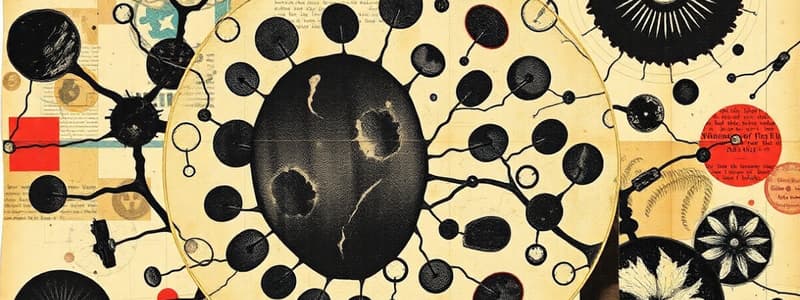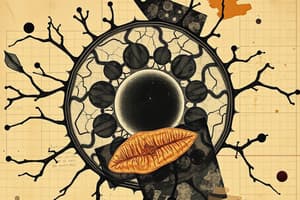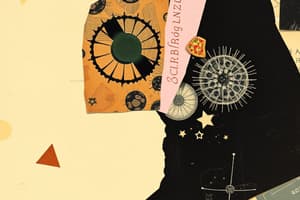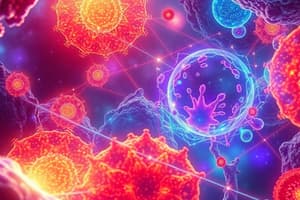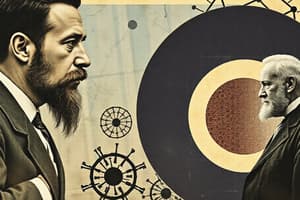Podcast
Questions and Answers
Who coined the term 'cell' while examining cork?
Who coined the term 'cell' while examining cork?
- Anton Van Leeuwonhoek
- Robert Hooke (correct)
- Rudolph Virchow
- Theodore Schwann
What major contribution did Anton Van Leeuwonhoek make to the field of microscopy?
What major contribution did Anton Van Leeuwonhoek make to the field of microscopy?
- Discovered the cell nucleus
- Built more than 500 microscopes (correct)
- First observed cell division
- Developed the first light microscope
Which scientist is credited with the discovery of the nucleus?
Which scientist is credited with the discovery of the nucleus?
- Theodore Schwann
- Robert Brown (correct)
- Rudolph Virchow
- Mathias Schleiden
What does the Cell Theory state about living organisms?
What does the Cell Theory state about living organisms?
Which of the following statements is true according to the Cell Theory?
Which of the following statements is true according to the Cell Theory?
What concept did Rudolph Virchow challenge in his studies of cells?
What concept did Rudolph Virchow challenge in his studies of cells?
Which of the following statements best describes the relationship between cells, tissues, and organisms?
Which of the following statements best describes the relationship between cells, tissues, and organisms?
Flashcards
Robert Hooke
Robert Hooke
English scientist who first used the term "cell" to describe the basic unit of life. He discovered this while observing cork under a microscope in 1660.
Anton Van Leeuwenhoek
Anton Van Leeuwenhoek
Dutch scientist who discovered microscopic organisms in 1675, which he called "animalcules". He built over 500 microscopes in his lifetime, significantly contributing to microscopy. However, he failed to observe their reproduction, perpetuating the idea of spontaneous generation.
Robert Brown
Robert Brown
Scottish physician who, in the 1830s, was the first to use the term "nucleus" to describe a prominent structure within cells.
Mathias Schleiden
Mathias Schleiden
Signup and view all the flashcards
Theodore Schwann
Theodore Schwann
Signup and view all the flashcards
Rudolf Virchow
Rudolf Virchow
Signup and view all the flashcards
Cell Theory
Cell Theory
Signup and view all the flashcards
Study Notes
Key Figures in Cell Theory
- Robert Hooke: English scientist who first used the term "cell" to describe cells, discovered this while viewing cork in 1660.
- Anton van Leeuwenhoek: Dutch scientist, major contributor to microscopy, built over 500 microscopes in his lifetime, observed single-celled organisms ("animalcules") but didn't understand their reproduction.
- Robert Brown: Scottish physician in the 1830s, coined the term "nucleus".
- Matthias Schleiden: Noted that cells were the basic units of plants.
- Theodore Schwann: Compared animal cells to plant cells.
- Rudolf Virchow: Stated that all cells come from pre-existing cells, challenging the idea of spontaneous generation. He also proposed that cells arise from inside existing cells.
Cell Theory
- Cells are the fundamental unit of all living things.
- All living things are composed of one or more cells.
- Cells are the basic unit of life, making them the smallest structural and functional unit with traits associated with living organisms.
- Cells come from pre-existing cells.
Cell Theory Progression
- Early observations and descriptions of cells laid the foundation.
- Schleiden and Schwann's work combined to further define cells and their role in all life forms.
- Virchow's work definitively established that cells do not arise spontaneously, but from pre-existing cells.
- This led to the modern understanding, now known as the Cell Theory.
Organizational Hierarchy of Life (Illustrative)
- Cells → Tissues → Organs → Organ Systems → Organisms
Studying That Suits You
Use AI to generate personalized quizzes and flashcards to suit your learning preferences.
